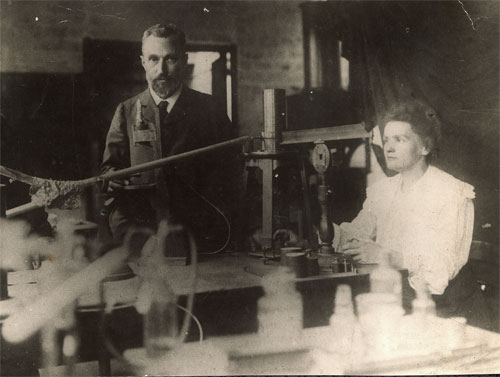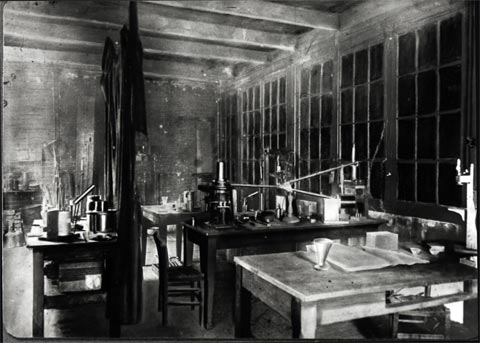Two new elements in Mendelyev’s periodic table

The 42 rue Lhomond shed
Pierre and Marie Curie in 1898, in the ‘discovery shed’ at the Ecole de Physique et Chimie Industrielles then situated at 42 rue Lhomond in Paris. Pierre Curie was already renowned for his work on piezoelectricity, the symmetry of crystals, and magnetism. He abandoned his own research to work with Marie Curie on the then unknown elements responsible for the Becquerel rays. Pierre Curie died in 1906 as the result of a tragic road accident.
© ACJC
In November 1897, Marie Curie decided to conduct systematic research on the ‘uranic rays’ found in a number of elements, compounds and minerals. She measured their ability to electrify the air surrounding them with a piezoelectric quartz electrometer invented by Pierre and Jacques Curie, capable of measuring very low values of electric intensity.
Marie Curie carried out these measurements and discovered that thorium also emits these ‘Becquerel rays’, and that uranium minerals such as pitchblende and chalcolite have infinitely more intense emissions that pure uranium. Uranium is a rare element(present in 3 parts per million on the Earth’s crust). Pitchblende is a mineral rich in uranium, that was used in the 19th Century to add colour to Bohemian crystals. Like pitchblende, chalcolite is a mineral often found in lead mines.
Marie Curie then proposed the hypothesis that the property of emitting these rays was a more general property of matter, which she named ‘radioactivity’. She added that the origin of the phenomenon must be inside the atom, as radioactivity occurs on a submolecular level.
Pierre Curie immediately understood the importance of these observations and together with his wife discovered two previously unknown elements in 1898: polonium and radium, present in trace amounts in pitchblende.
From several tonnes of pitchblende residue, Marie Curie was able to isolate pure radium, an element which is a million times more radioactive than uranium. Radium salts also possess a remarkable quality: they glow in the dark, are warm to the touch and seem to give off an inexhaustible supply of heat.
In 1902, Mendeleyev’s periodic table still had gaps. Marie Curie was able to show that radium filled in one of these pieces in the jigsaw, and demonstrated that it had an atomic mass of 226. The atomic mass is today defined as the total number of protons and neutrons forming up a nucleus. Marie Curie was able to narrow down the accuracy on radium atomic mass to 1 nucleon.
In 1903, Pierre et Marie Curie were rewarded by a Nobel Prize shared with Henri Becquerel (in 1911 Marie Curie was again rewarded by a second Nobel Prize).
The new element, the radium, became an extraordinary tool for the early exploration of the structure of matter and also for its therapeutical applications.

Pierre and Marie Curie’s workshop
It was in these modest settings at the ‘Hangar’ of the Ecole Municipale de Physique et Chimie on the rue Lhomond in Paris that Pierre and Marie Cure conducted the research that led to the discovery of polonium and radium in 1898.
© ACJC
See also : uranium
Other articles on the subject « Discoveries »
Three radiations
Understanding the nature of alpha, beta and gamma rays In the years following the discovery of ra[...]
Discovery of the Nucleus
A new vision of the atom In 1911, Rutherford, Marsden and Geiger discovered the dense atomic nucl[...]
Ernest Rutherford
In October 1895, landed in England a 24 years-old young New Zealander. His name was Ernest Ruther[...]
Rutherford’s experiment
The experiment which proved the existence of a nucleus in the atom In 1908, Ernest Rutherford rec[...]
The neutron : Chadwick
A close competition between great physicists … James Chadwick, who discovered the neutron i[...]
Radium and Medicine
A short history: first steps in nuclear medicine … Everyone knows that the discovery of rad[...]
1934 : Artificial Radioactivity
The production at will of radioactive isotopes In the first days of 1934, Frederic and Irene Joli[...]
The Neutrino Hypothesis
The remarkable story of the neutrino The study of radioactive disintegrations had established tha[...]
Fission discovery
A nuclear phenomenon that escaped the hands of physicists In the years spanning 1934 to 1938, Enr[...]
Enrico Fermi
A genial experimenter and theoretician Enrico Fermi (Rome, September 29, 1901 – Chicago, No[...]